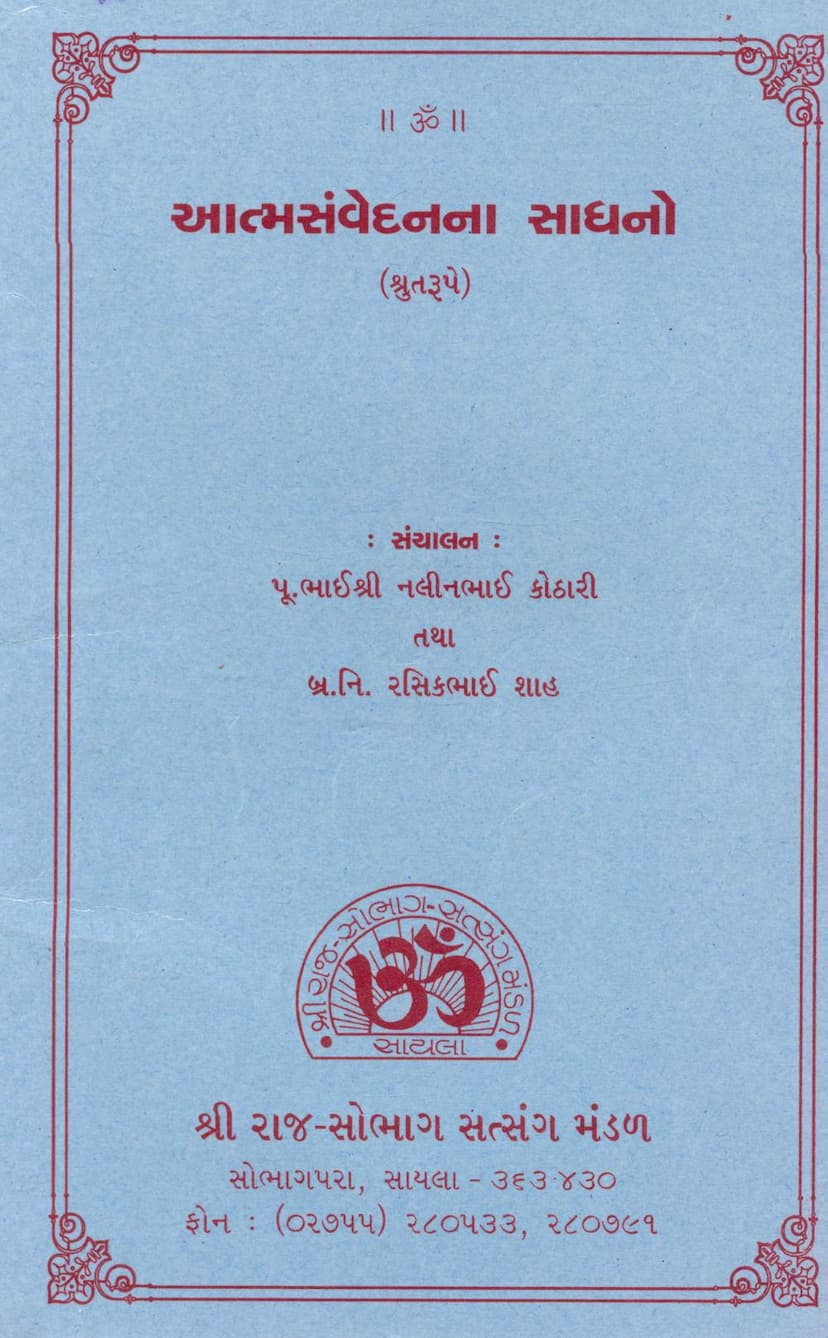Aatm Samvedanna Sadhano
Added to library: September 1, 2025

Summary
This Jain text, titled "Aatm Samvedanna Sadhano" (Tools for Self-Realization), is a compilation of spiritual guidance presented in a structured manner. The book, brought out by Shri Raj-Saubhag Satsang Mandal Saila, features the esteemed guidance of Pujya Bhai Shri Nalinbhai Kothari and Brahmachari Shri Rasikbhai Shah. It's presented as Volume 3 of a series.
The core purpose of the book, as outlined in the preface, is to provide spiritual seekers with the necessary tools for their Sadhana (spiritual practice). This is particularly relevant to the spiritual sadhaks at Shri Rajsobhag Ashram, where the Mandal operates. To strengthen their practice, the "Shri Rajmarg Yogarohan Prakalp" was initiated, which includes monthly silent meditation camps and worship camps, with a strong emphasis on meditation.
To facilitate a deeper understanding of spiritual topics, the book draws upon the teachings of ancient self-realized souls. The compilation focuses on several key scriptural texts and themes:
-
Bhav Vairagya Shatak (Century on Detachment): Attributed to Shri Ratneshkhsuriji, this text aims to cultivate detachment (Vairagya) born from wisdom. It's presented as essential for rapid spiritual progress, emphasizing that detachment is the key to infinite happiness. This work is believed to help remove the poison of attachment and aversion, fostering detachment in the hearts of noble souls. The text addresses all three types of attachment (Neh-raag, Kaam-raag, and Drishti-raag) and various forms of aversion.
-
Samya Shatak (Century on Equanimity): Authored by Shri Vijaysinhsuriji Maharaj, this text highlights equanimity (Samya) as the supreme secret of the Jain religion. It states that any spiritual practice culminating in equanimity leads to liberation. The text thoroughly explains the nature of equanimity through 106 Sanskrit verses.
-
Samta Shatak (Century on Equanimity): This work, written in Gujarati verse by Nyayavisharad Nyayacharya Mahopadhyaya Shri Yashovijayji Maharaj, is based on the Sanskrit "Samya Shatak." It focuses on cultivating equanimity within the soul, maintaining neutrality during situations of attachment and aversion, and developing a sense of detachment towards worldly pleasures.
-
Aatmgyan Na Sadhano (Tools for Self-Knowledge): This section is derived from Shri Hemchandracharya's "Yogashastra" and includes its translation. It is considered highly useful for spiritual progress and systematically details the twelve Bhavanas (contemplations). Through the contemplation of these Bhavanas, the practitioner can strengthen their Vairagya and understand how to progress detached from worldly matters.
The preface concludes by expressing the hope that through the study of these texts, practitioners will be able to manifest detachment and equanimity, thereby overcoming the "army of illusion" and progressing spiritually.
Key Themes and Content Highlights:
- The Impermanence of the World: Numerous verses from the "Bhav Vairagya Shatak" are quoted, emphasizing the transient nature of life, relationships, possessions, and worldly pleasures. The text repeatedly highlights that attachment to these fleeting things leads to suffering.
- The Power of the Soul and Karma: The text stresses that an individual's happiness and suffering are a result of their own actions (karma). It urges readers to focus on self-effort and not rely on external factors.
- The Importance of Dharma (Righteousness) and Spiritual Practice: The verses consistently advocate for engaging in spiritual practices, especially during the prime of life, before old age, disease, or death intervene.
- The Illusory Nature of the World: The text uses metaphors like a dream, a mirage, and bubbles to describe the transient and often deceptive nature of worldly experiences and relationships.
- The Path of Detachment and Equanimity: A central theme is the cultivation of Vairagya (detachment) and Samata/Samya (equanimity/equipoise) as the primary means to overcome suffering and attain liberation.
- The Dangers of Attachment and Worldly Desires: The text repeatedly warns against the pitfalls of attachment to family, wealth, sensory pleasures, and the ego, stating that these lead to immense suffering and the cycle of birth and death.
- The Impermanence of Youth and Strength: The text laments the loss of youth, strength, and beauty, emphasizing that these are temporary and ultimately taken away by time.
- The True Refuge: It posits that true refuge lies not in worldly possessions or relationships but in the eternal teachings of the Tirthankaras and the practice of Dharma.
- The Role of the Guru: The text briefly touches upon different types of gurus, emphasizing the importance of a self-realized guru who can guide others across the ocean of existence.
- The Twelve Bhavanas (Contemplations): The "Aatmgyan Na Sadhano" section details the twelve Bhavanas, which are instrumental in developing spiritual understanding and detachment. These include contemplations on impermanence, suffering, the self, solitude, others, purity, influx of karma, stoppage of karma, exhaustion of karma, the path of liberation, the world, and the rarity of obtaining the human birth and the right faith.
- The Nature of the Soul and Liberation: The text delves into the spiritual nature of the soul, its connection with karma, and the process of liberation through self-knowledge, right conduct, and meditation. It emphasizes that the soul is inherently pure and blissful, and its bondage is due to ignorance and the influence of karma.
- The Importance of Mind Control: A significant portion of the text, particularly from the later chapters and the "Samta Shatak" and "Aatmgyan Na Sadhano" sections, focuses on the control of the mind and senses. It describes how unchecked senses and desires lead to suffering and how they can be brought under control through detachment, equanimity, and spiritual wisdom.
- The Efficacy of Forgiveness and Peace: The text highlights the power of Kshama (forgiveness) and Samata (equanimity) in overcoming anger, ego, and other negative emotions.
In essence, "Aatm Samvedanna Sadhano" serves as a practical guide for Jain spiritual aspirants, offering profound insights and scriptural support to navigate the path of self-realization by cultivating detachment, equanimity, and wisdom, and by understanding the true nature of the soul and the world.